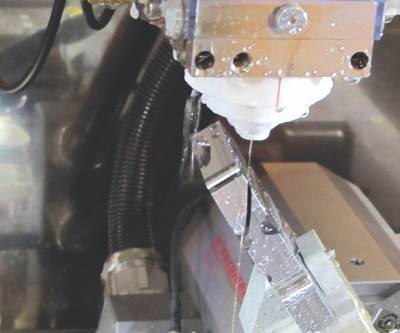Buying a Wire EDM, Part 1: How It Works
Wire EDMs can cut parts that require a level of accuracy, intricacy and fine surface finish that traditional machining methods cannot achieve. Here’s how it works.
Share





This is part one of a four-part series about buying a wire EDM. For more on Wire EDM, click the links:
- Part Two: Wire Considerations
- Part Three: Speed, Accuracy and Finish
- Part Four: Dielectric Fluid & Maintenance
Find more insights about acquiring a new machine tool by visiting the Techspex Knowledge Center.
Wire electrical discharge machining (EDM) is widely used to create dies, punches, mold components, special tooling, extrusion dies, airfoils, gears, medical instruments, carbide cutters, toolholders, jewelry and thousands of workpieces too numerous to list.
Wire EDM’s Capabilities
Wire EDM can be used to cut electrically conductive materials to make parts that require a level of accuracy, intricacy and fine surface finish that traditional machining methods cannot achieve. A wire EDM unit can be programmed to cut complex shapes (small or large) to a dimensional tolerance of ±0.0001 inch and can be trusted to do so repeatedly and reliably. Unlike other types of machining, wire EDM exerts no cutting force on the workpiece and introduces no residual stress. There is little or no change in the mechanical properties of the material. Today’s wire EDM technology is capable of leaving virtually no thermal effects on the surface.
Wire EDM is best at cutting extremely hard materials such as tool steels, carbide, polycrystalline diamond (PCD), special alloys and parts requiring complex shapes, angles, tapers and sharp internal corners. Wire EDM can provide a surface finish as fine as 4 microinches Ra that may require no additional finishing or polishing. The wire EDM process leaves no burrs on the workpiece, a result that greatly reduces the need for subsequent operations. Wire EDM can be considered a time-saving, one-step process.
Wire EDM rarely calls for expensive workholding fixtures. One operator can run multiple machines.
How Wire EDM Works
A typical system consists of a CNC unit, a power supply with anti-electrolysis circuitry, a mechanism for automatic wire threading, a tank to contain the dielectric fluid, a chiller to keep the fluid at a steady temperature and a filtration system to keep the dielectric clean.
Wire EDM uses an electrically charged strand of wire fed from a reel and moved through upper and lower guides. The wire is energized as it passes across a power contact at the top and bottom. The distance between the guides can be adjusted to accommodate the thickness of the workpiece. A tightly controlled sequence of electrical discharges between the wire and the workpiece creates hundreds of thousands of sparks per second to remove the workpiece material. The heat of each electrical spark, estimated at around 15,000-21,000°F, melts away a microscopic bit of the workpiece material. Although the volume of metal removed during this short period of intense heat lasting 1 millionth of a second or less it is quite small, the frequency and multitude of sparks is an effective method to cut a narrow slot through very hard materials. The action of the spark may also remove material from the wire at the same time.
Submerging the wire and part in deionized water allows cutting debris to be flushed away. Splash flushing can be used when the part cannot be fully submerged, but a top and bottom nozzle must be constantly directed at the wire to help wash away debris. When machining submerged, cutting occurs in a more easily controlled environment and the flushing nozzles need to be adjusted only once.
A CNC unit moves the machine in an X-Y plane and can position the upper guide independently in the U-V axis, giving the machine the ability to move all four axes (X, Y, U, V) simultaneously to cut tapers or shapes that transition from top to bottom. A programmable Z-axis enables workpieces with different thickness to be machined automatically.
Related Content
How to Determine the Currently Active Work Offset Number
Determining the currently active work offset number is practical when the program zero point is changing between workpieces in a production run.
Read More5 Tips for Running a Profitable Aerospace Shop
Aerospace machining is a demanding and competitive sector of manufacturing, but this shop demonstrates five ways to find aerospace success.
Read MoreHigh RPM Spindles: 5 Advantages for 5-axis CNC Machines
Explore five crucial ways equipping 5-axis CNC machines with Air Turbine Spindles® can achieve the speeds necessary to overcome manufacturing challenges.
Read MoreHow to Mitigate Chatter to Boost Machining Rates
There are usually better solutions to chatter than just reducing the feed rate. Through vibration analysis, the chatter problem can be solved, enabling much higher metal removal rates, better quality and longer tool life.
Read MoreRead Next
Buying a Wire EDM, Part 2: Wire Considerations
Each type of EDM wire has its strengths and weaknesses. This post reviews wire types, the importance of tensile strength and wire rethreading.
Read More5 Rules of Thumb for Buying CNC Machine Tools
Use these tips to carefully plan your machine tool purchases and to avoid regretting your decision later.
Read MoreBuilding Out a Foundation for Student Machinists
Autodesk and Haas have teamed up to produce an introductory course for students that covers the basics of CAD, CAM and CNC while providing them with a portfolio part.
Read More





























